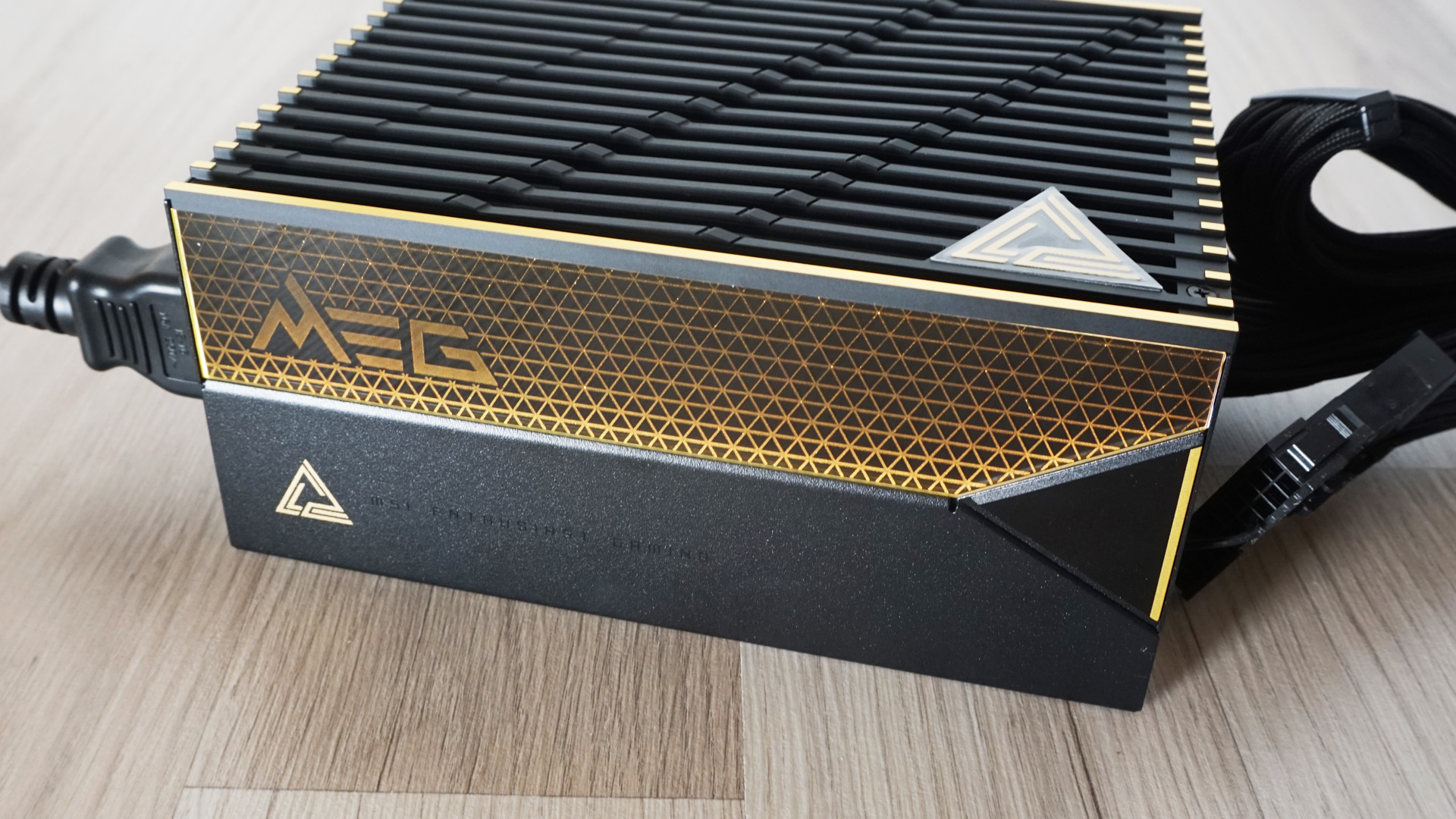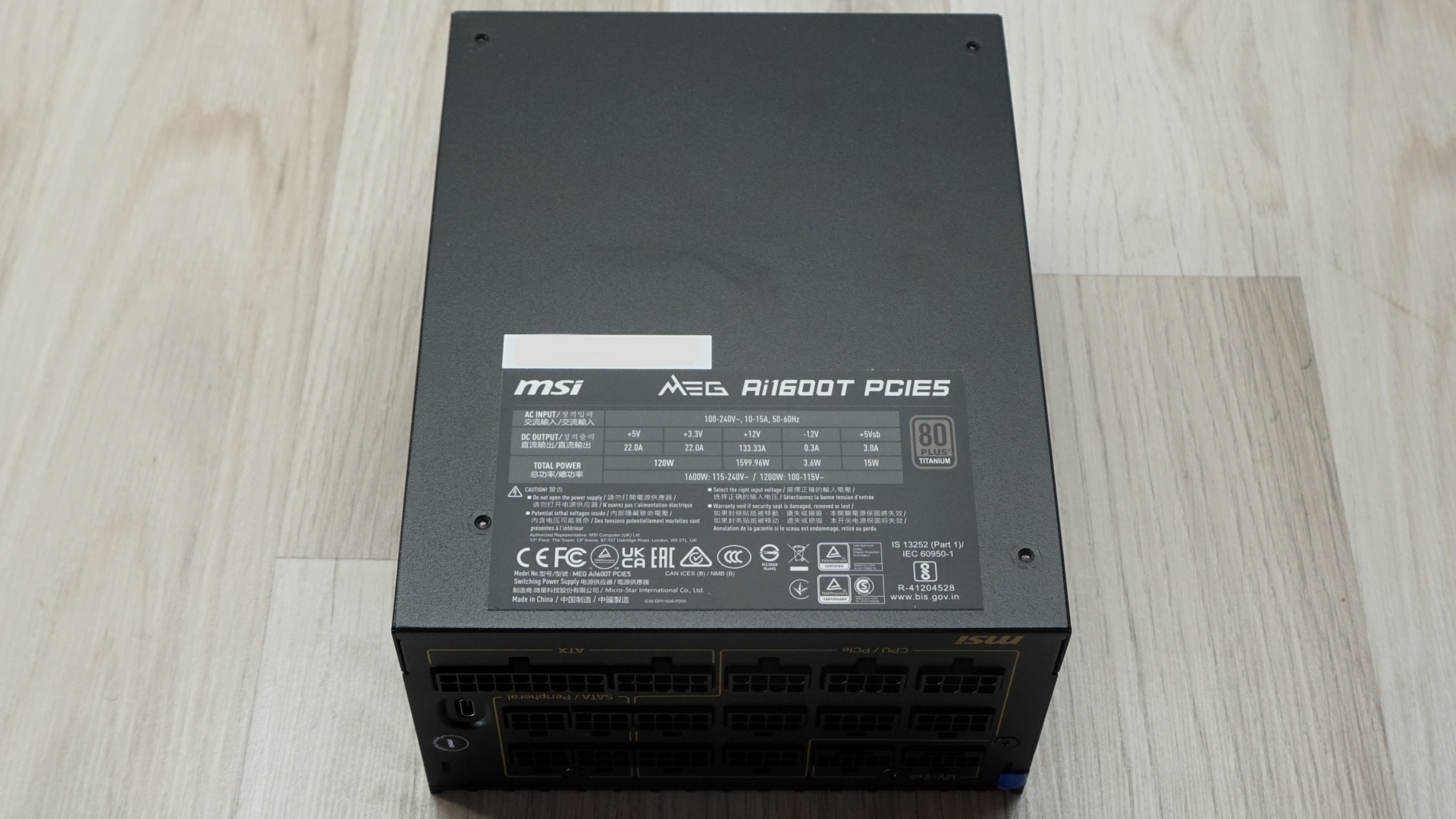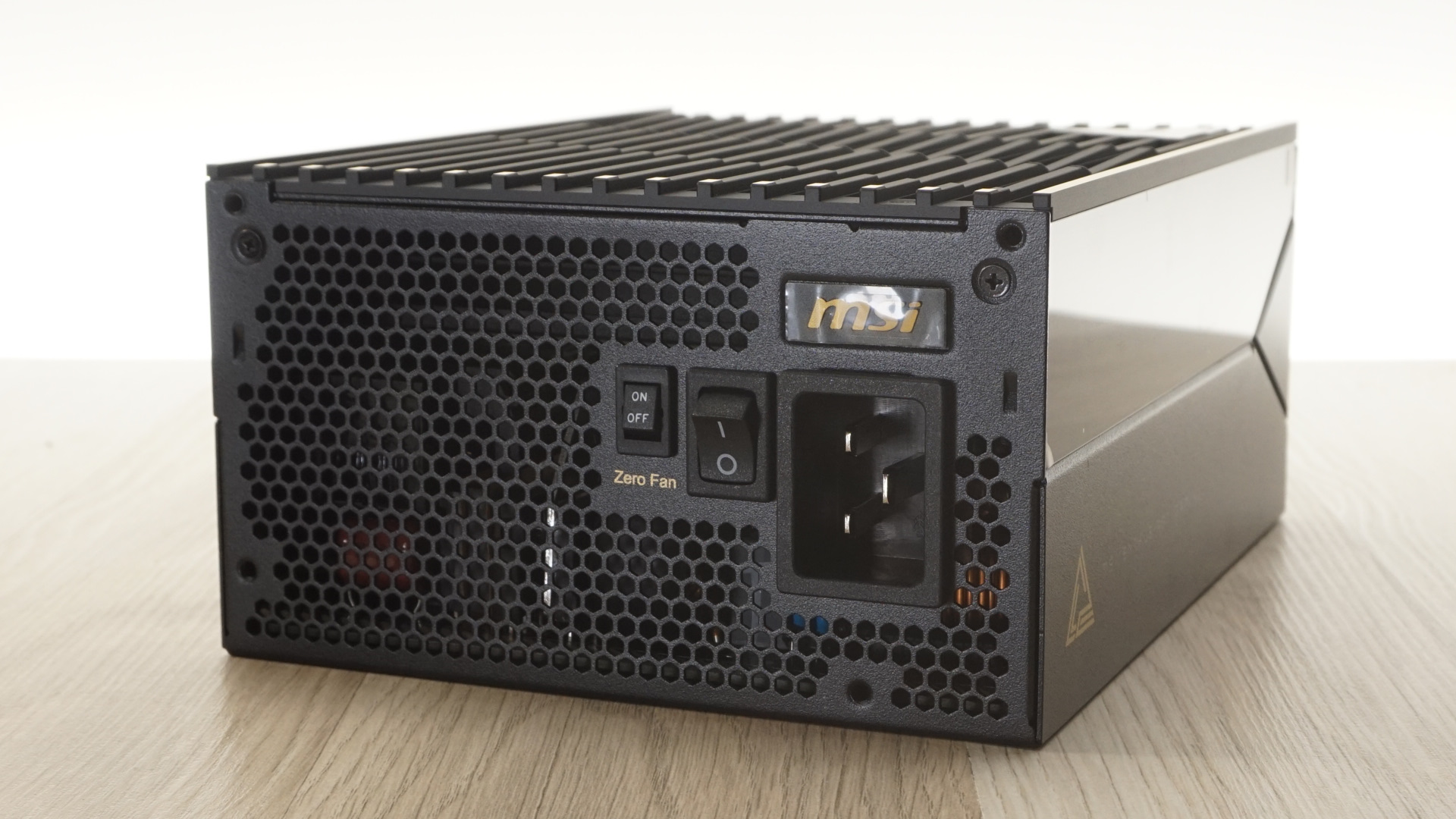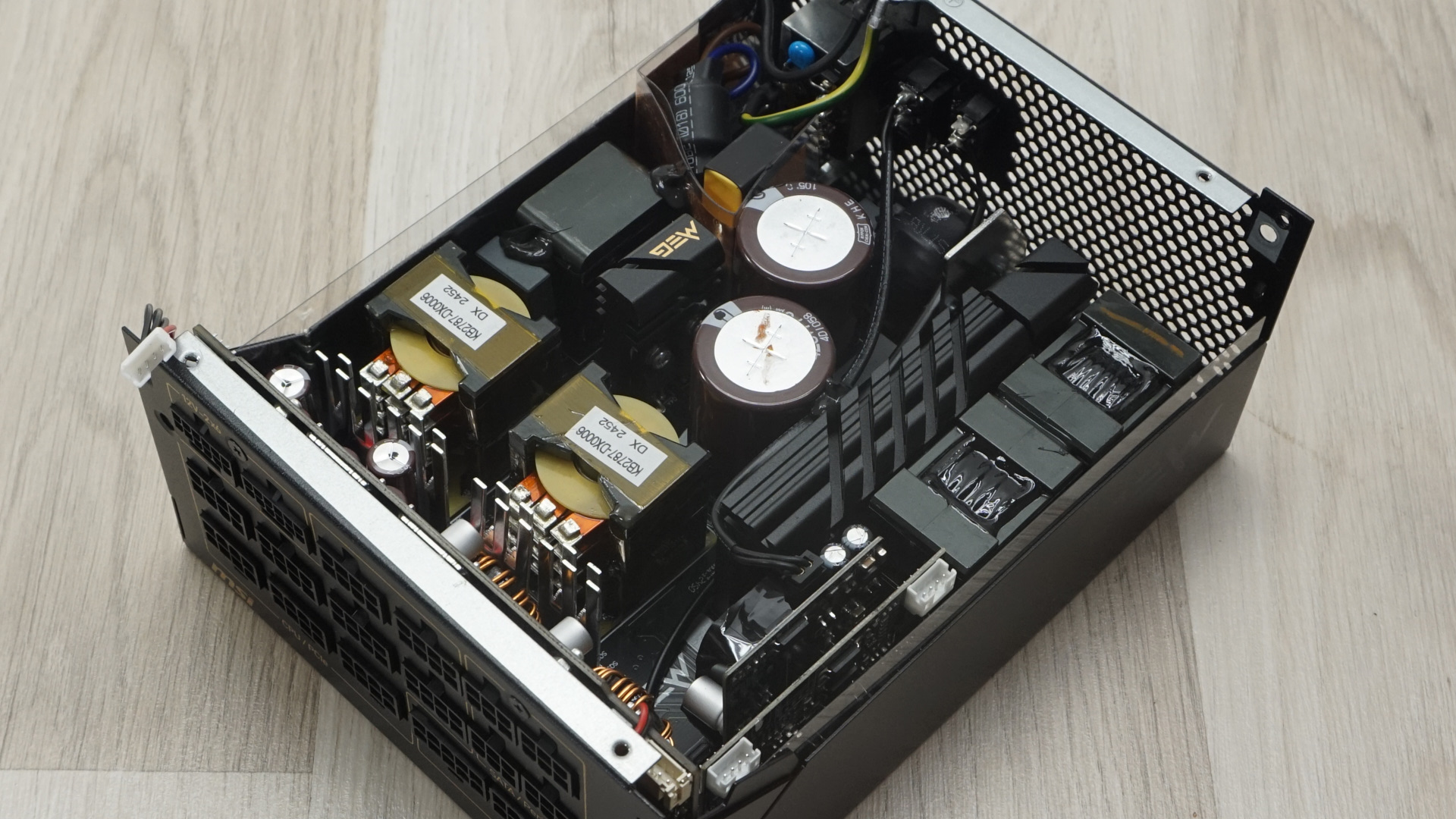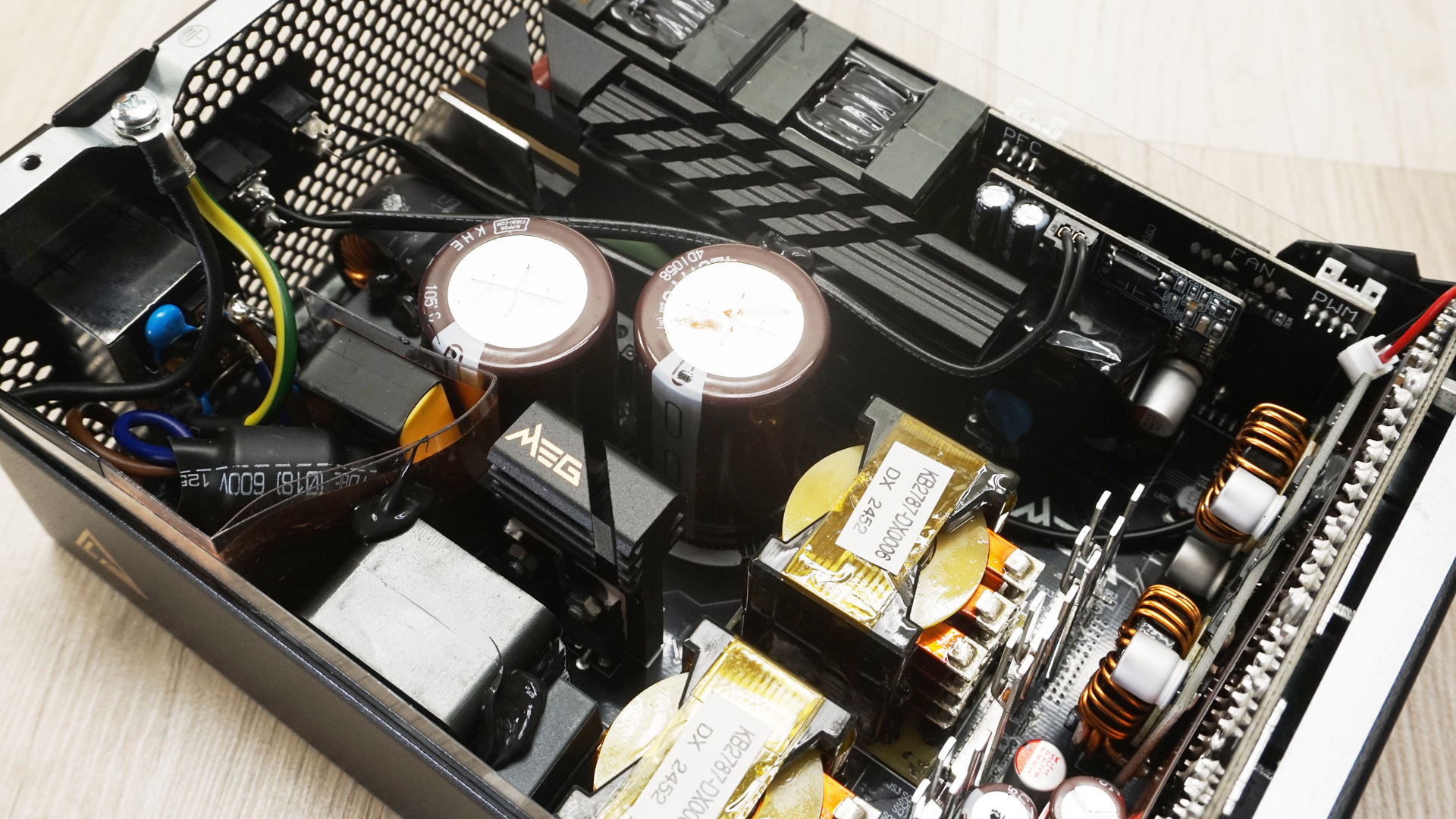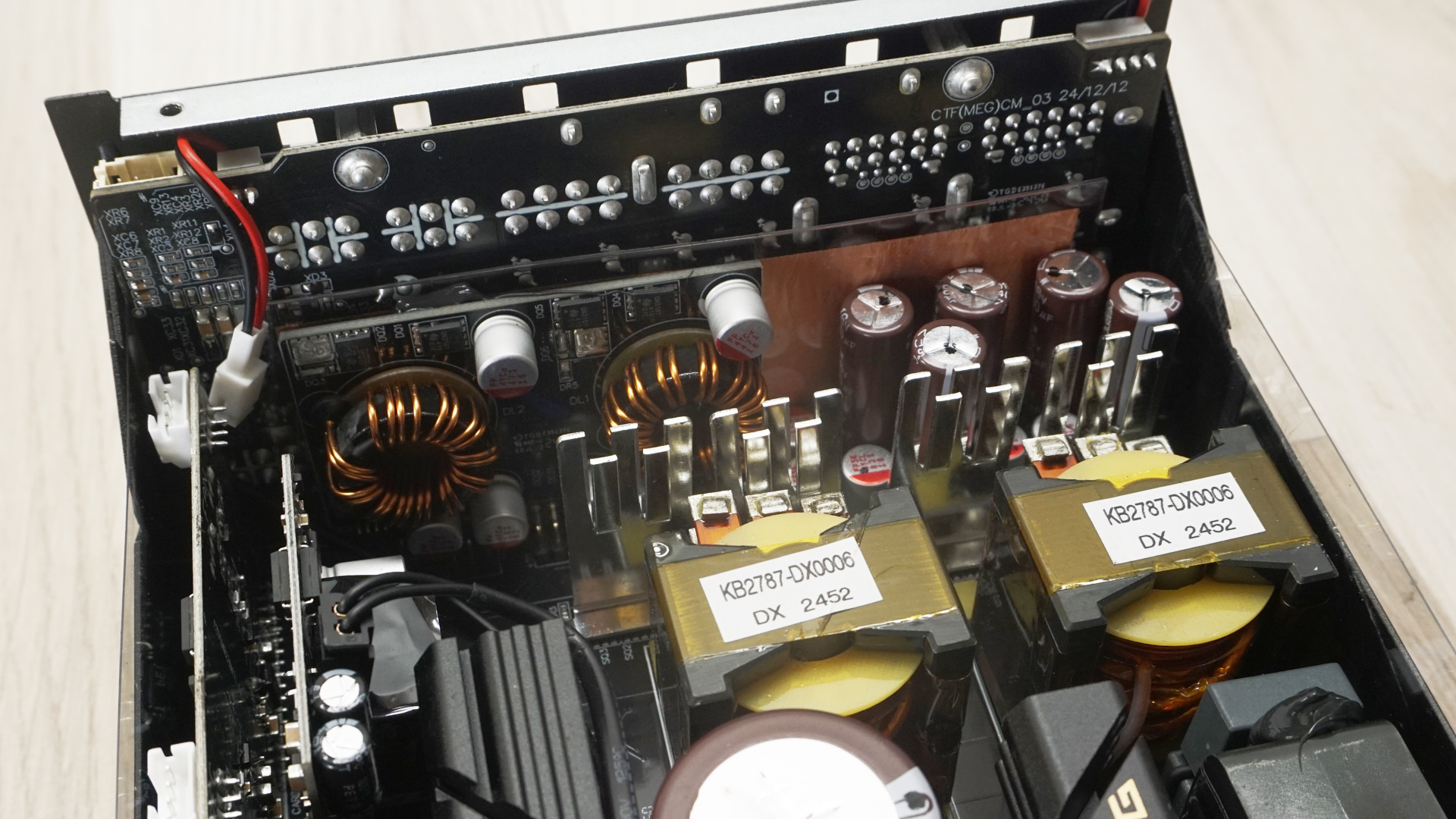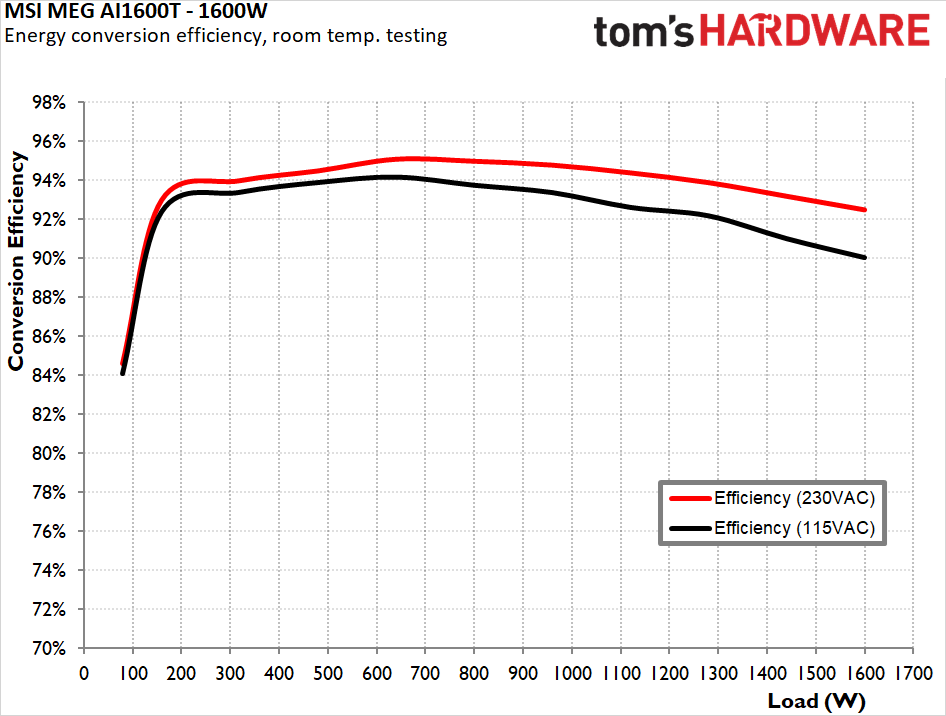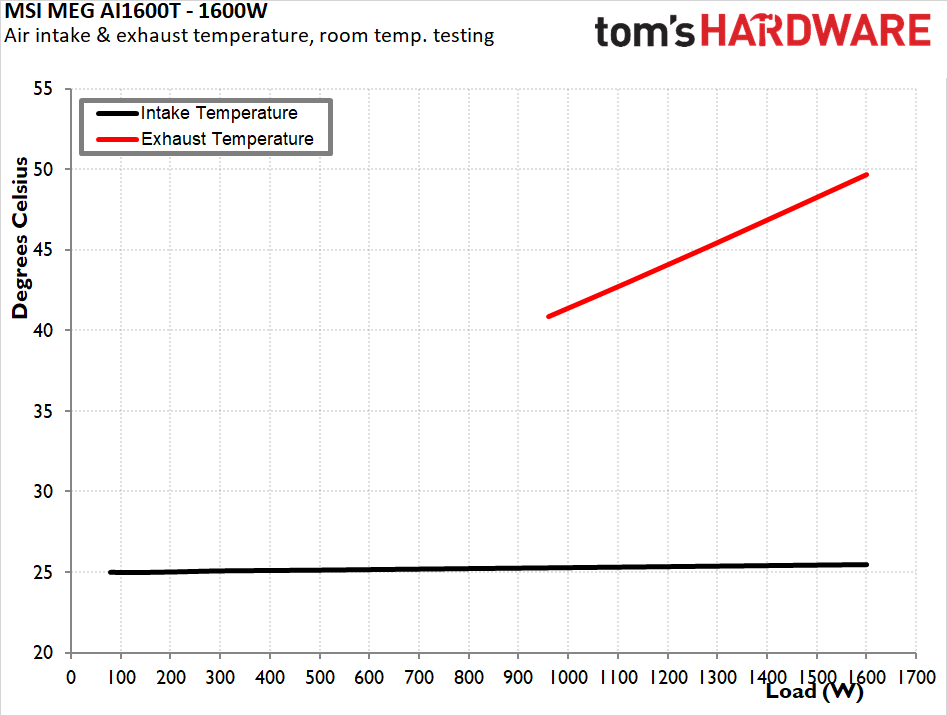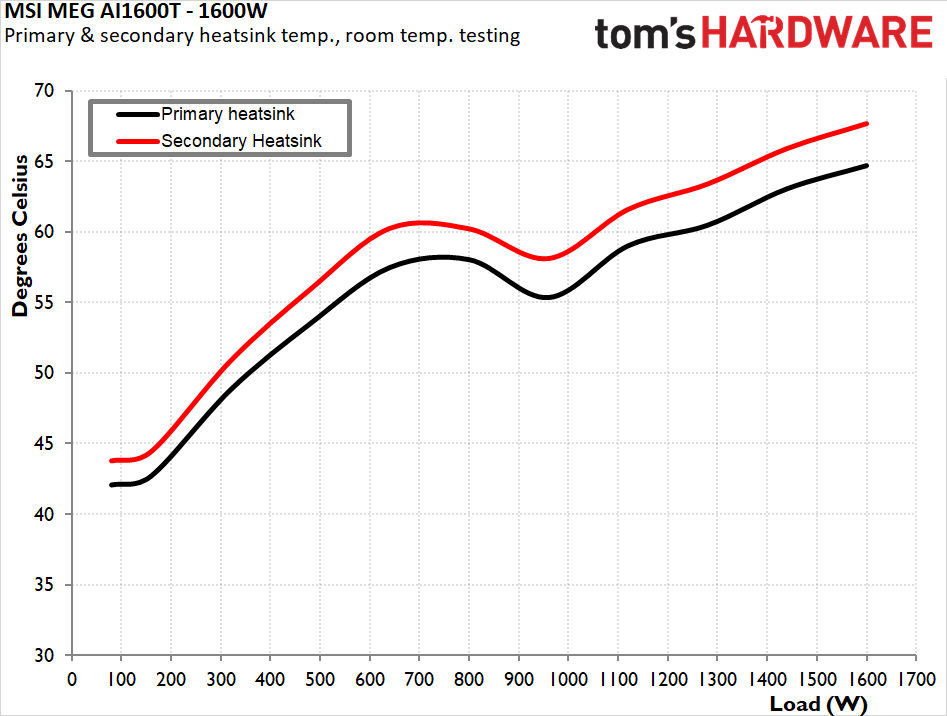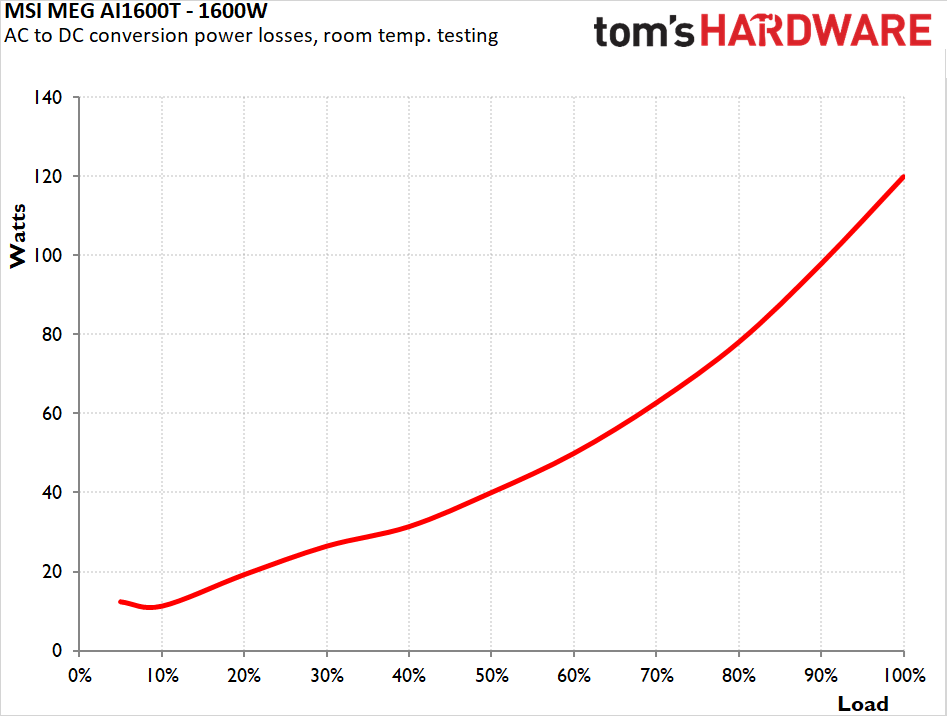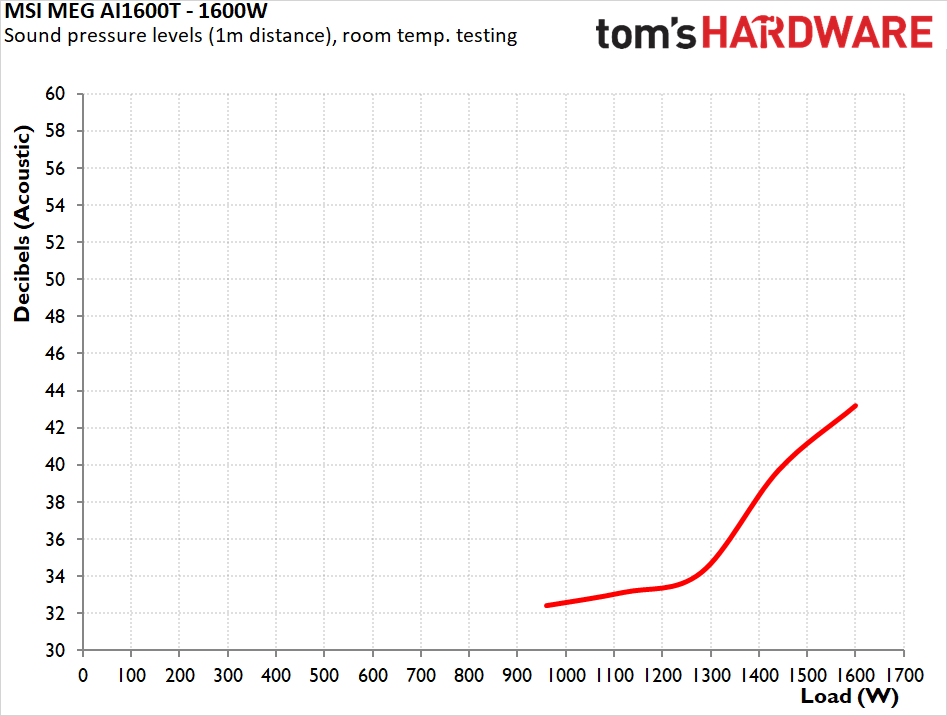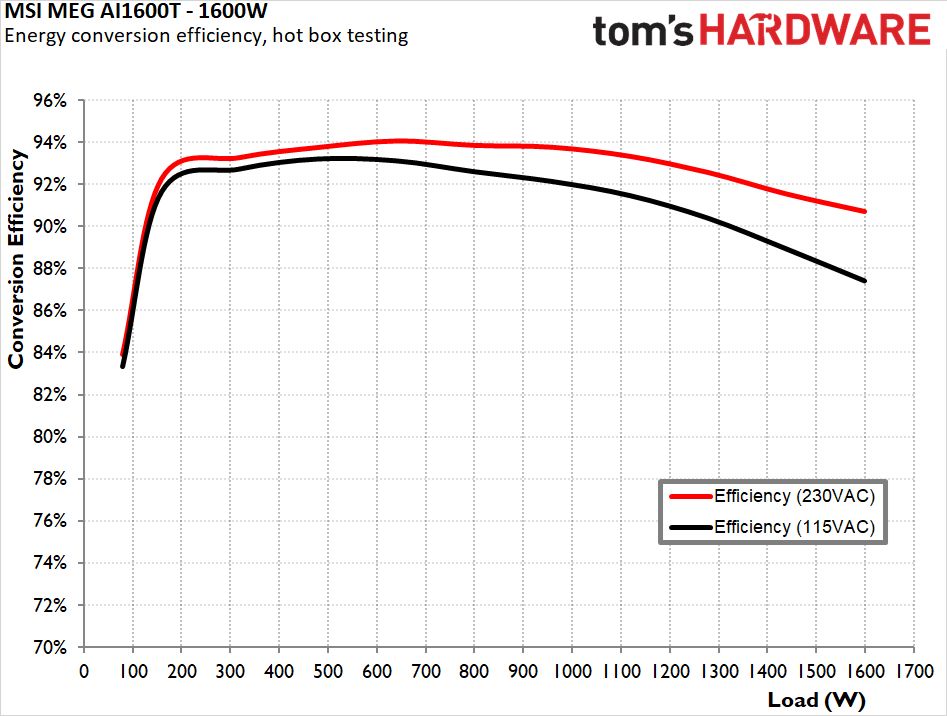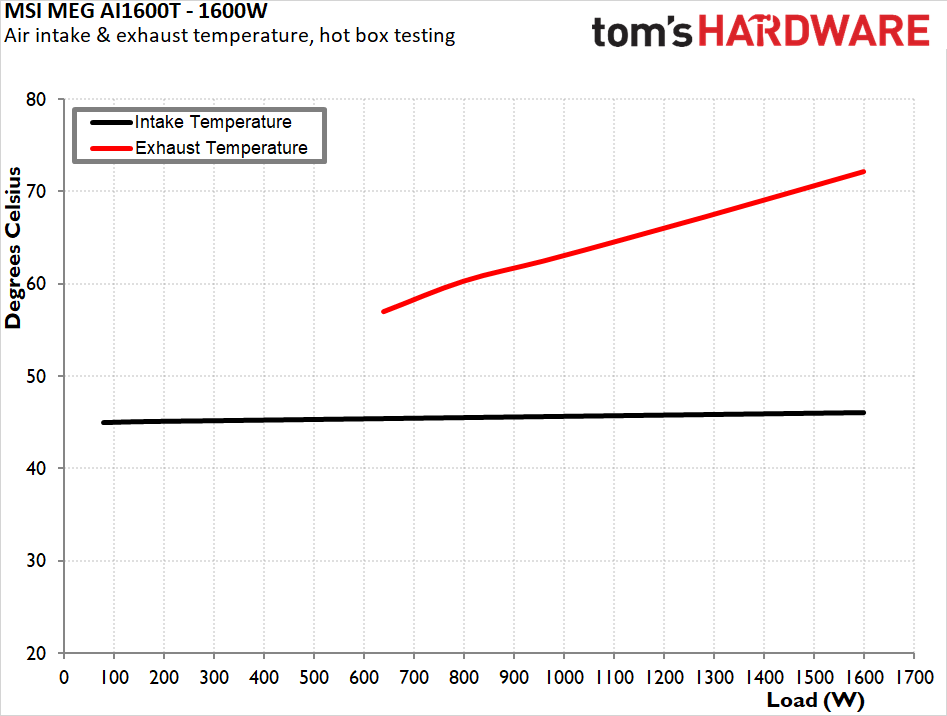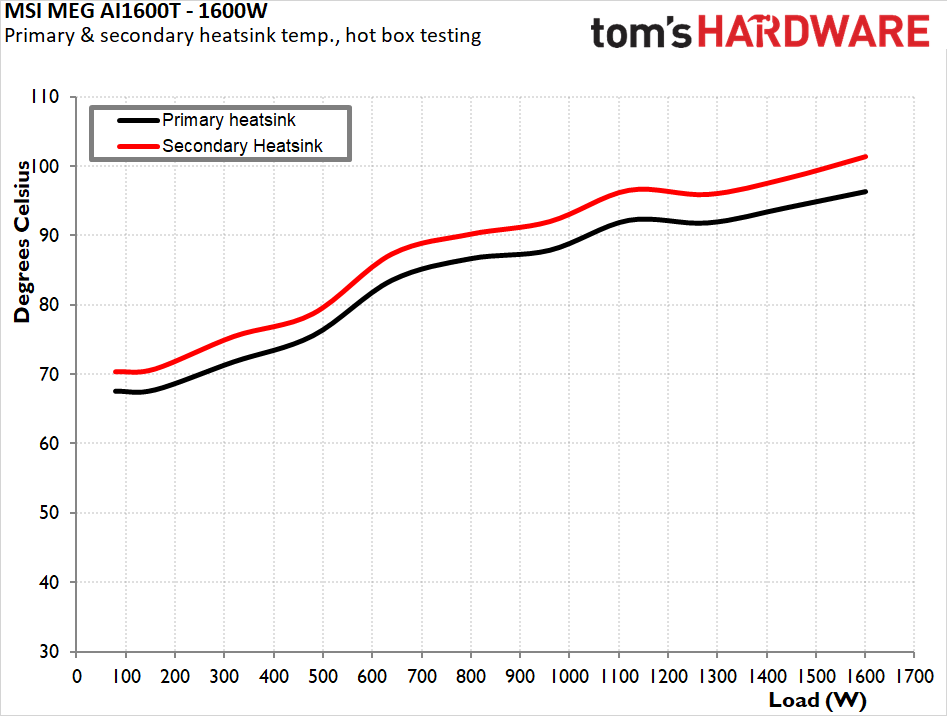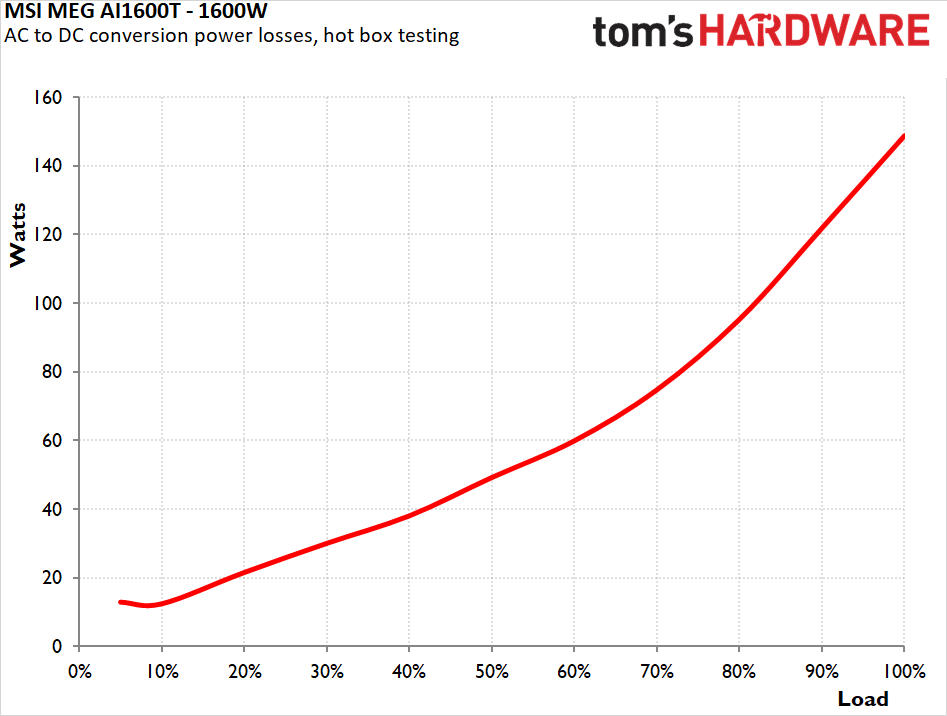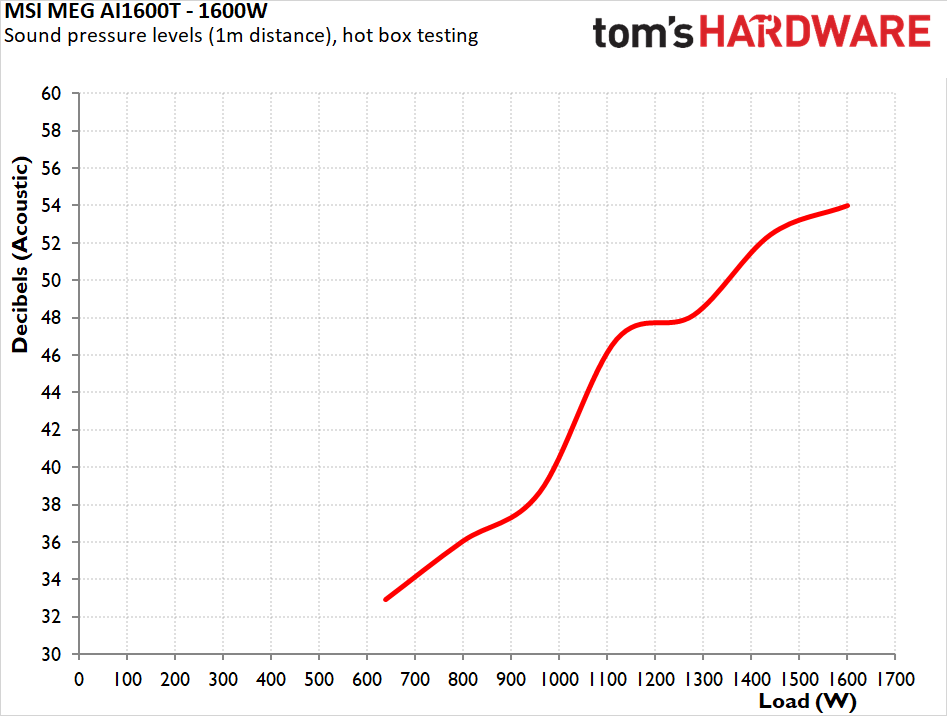Why you can trust Tom’s Hardware
Our expert reviewers spend hours testing and comparing products and services so you can choose the best for you. Find out more about how we test.
MSI (Micro-Star International) has established itself as a major player in the PC component market, with products ranging from motherboards and graphics cards to complete systems. While the company has offered power supplies for some time, it has recently expanded its premium lineup with showcase products aimed at the enthusiast segment.
We take a closer look at the MSI MEG AI1600T PCIE5 to determine if it deserves a place in our best power supplies list. The MEG AI600T PCIE5 is a flagship power supply representing the absolute pinnacle of MSI’s power delivery solutions. This ultra high-end unit features Titanium-level efficiency and a substantial 1600W rating, targeting users with extreme power requirements such as professional workstations and enthusiast systems with multiple high-end components. The unit is fully compliant with the latest ATX 3.1 and PCIe 5.1 standards, ensuring compatibility with current and upcoming hardware generations, particularly power-hungry GPUs with significant transient power demands.
Specifications and Design
RAIL | +3.3V | +5V | +12V | +5Vsb | -12V |
MAX OUTPUT | 22A | 22A | 133.33A | 3A | 0.3A |
| Row 2 – Cell 0 | 120W | Row 2 – Cell 2 | 1600W | 15W | 3.6W |
TOTAL | 1600W | Row 3 – Cell 2 | Row 3 – Cell 3 | Row 3 – Cell 4 | Row 3 – Cell 5 |
AC INPUT | 100 – 240 VAC, 50 – 60 Hz | Row 4 – Cell 2 | Row 4 – Cell 3 | Row 4 – Cell 4 | Row 4 – Cell 5 |
PRICE | $690 | Row 5 – Cell 2 | Row 5 – Cell 3 | Row 5 – Cell 4 | Row 5 – Cell 5 |
In the Box
The MSI MEG AI1600T arrives in a substantial, premium packaging presentation that immediately communicates its flagship status. The large, remarkably sturdy cardboard box features a sophisticated black design with tasteful golden accents and a decorative paper ribbon that enhances the luxury unboxing experience. Inside, the PSU is thoroughly protected by a soft pouch and dense foam inserts that ensure safe transportation.
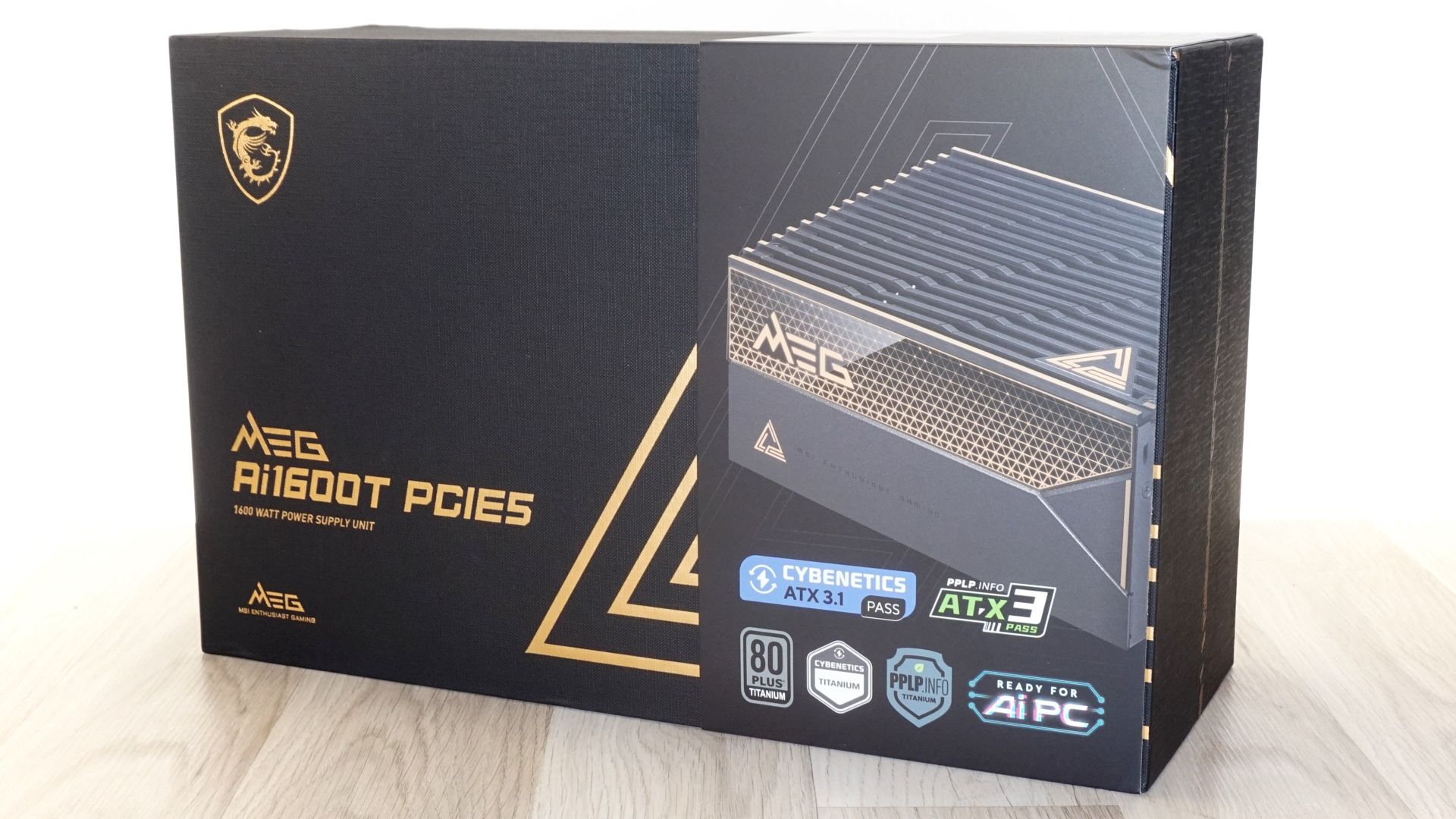
The included bundle is comprehensive but somewhat unfit of the unit’s class, consisting of necessary mounting screws, a C19 AC power cable, ten basic cable straps, and an envelope containing the unit’s detailed test report and basic information. A soft microfiber bag is included for storing unused cables.
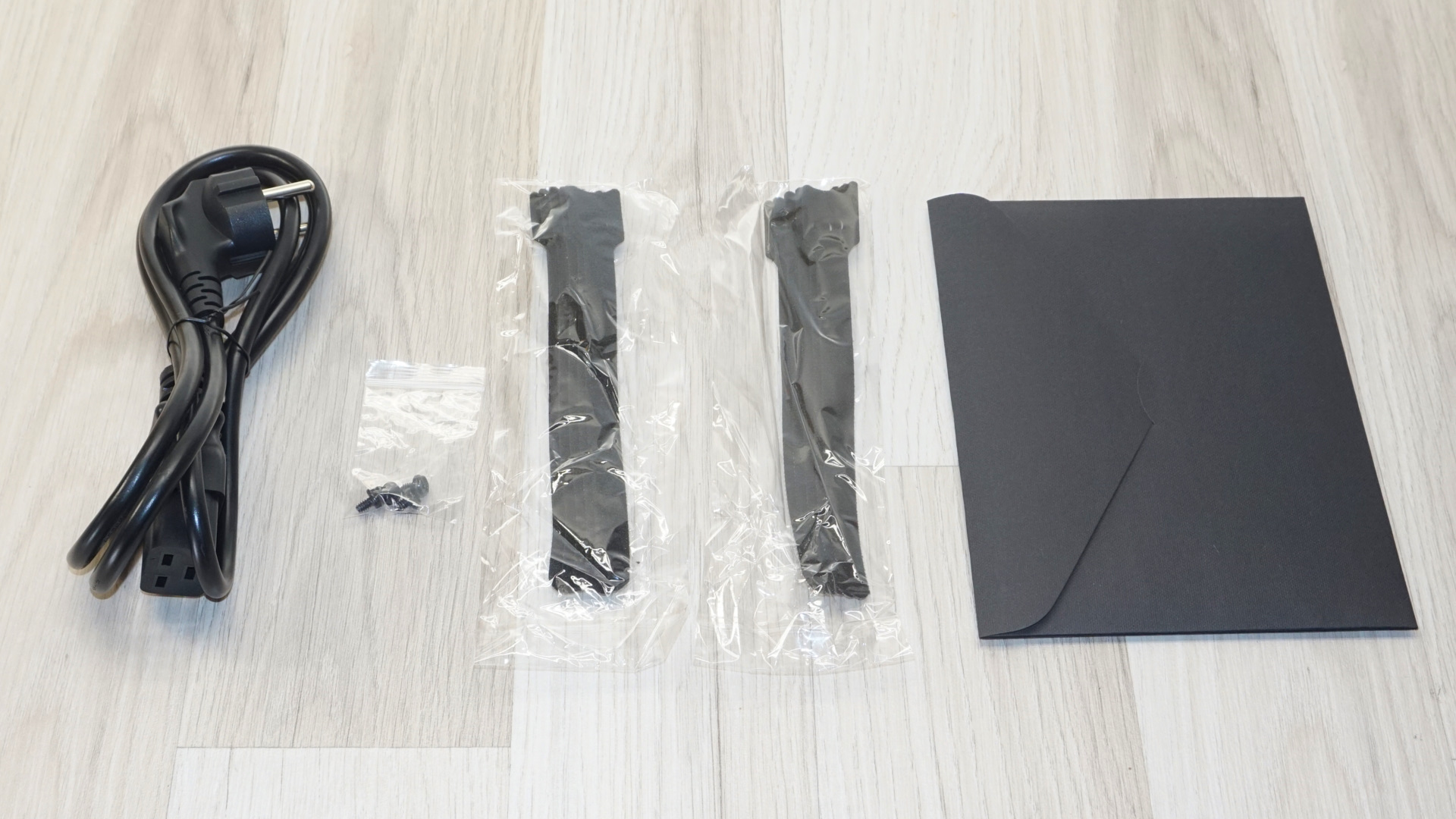
The MEG AI1600T features predominantly black connectors across its cable set, with a distinctive safety feature on the 12V-2×6 connectors – they incorporate a half-yellow design that visually confirms proper connection when the yellow portion disappears completely. All ATX, EPS, and PCIe cables feature individually sleeved black wires with pre-installed combs, while the SATA and Molex connector cables use a more standard ribbon-like design, an approach that may cause a small visual dissonance and dissuade perfectionists. The package also includes a USB-C to internal USB header cable that enables motherboard connection for software monitoring and control capabilities.
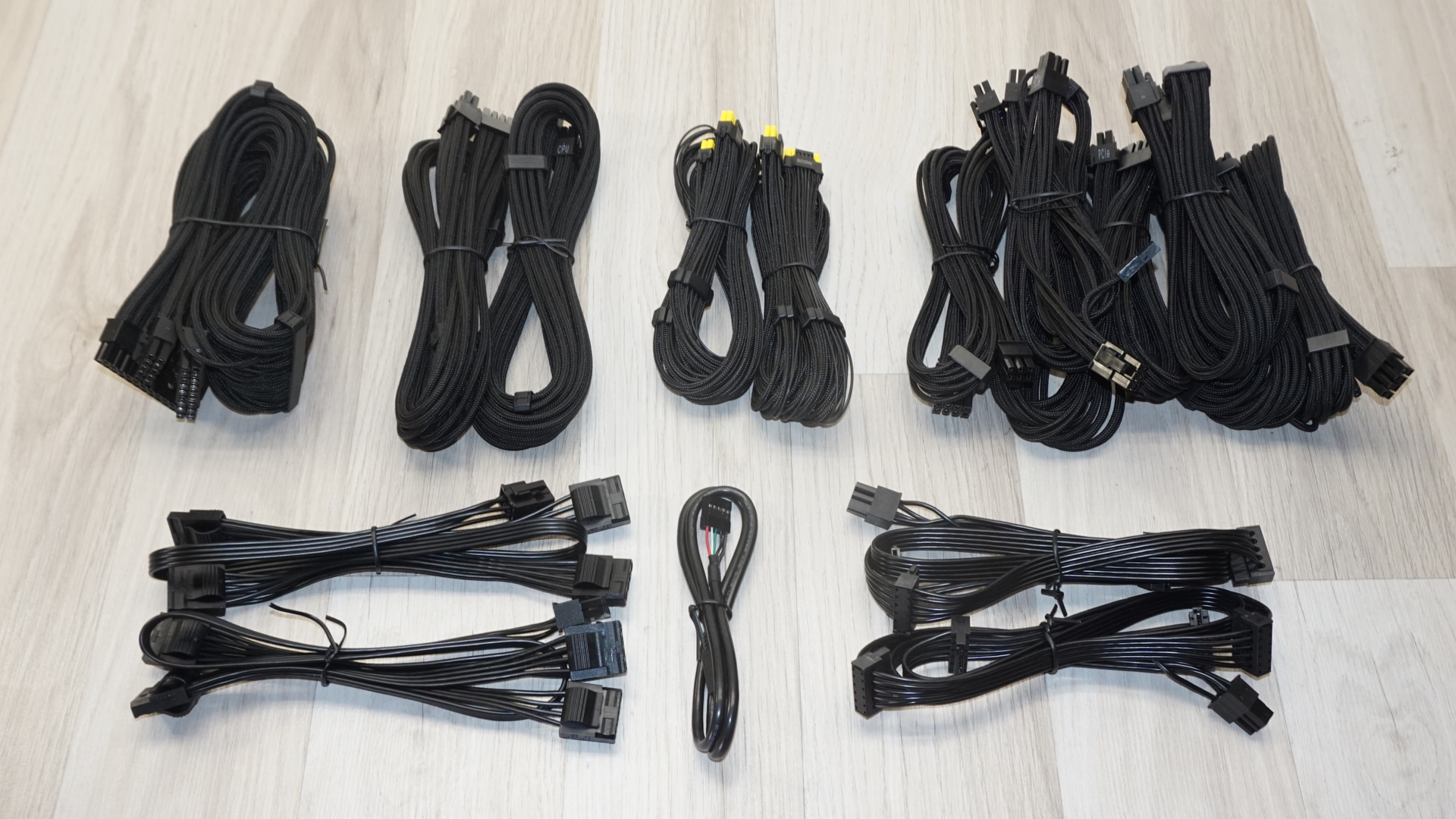
Connector type | Hardwired | Modular |
|---|---|---|
ATX 24 Pin | – | 1 |
EPS 4+4 Pin | – | 2 |
EPS 8 Pin | – | – |
PCI-E 5.0 | – | 2 |
PCI-E 8 Pin | – | 9 |
SATA | – | 8 |
Molex | – | 8 |
Floppy | – | – |
External Appearance
The MSI MEG AI1600T PCIE5 features a distinctive and premium design that sets it apart from conventional power supplies. The unit employs a hybrid construction with both aluminum and steel elements, primarily finished in a sophisticated satin black with subtle golden accents. At 190 mm in length, it significantly exceeds the standard ATX dimension. While this extended length should not pose issues for most modern enthusiast cases, potential buyers should verify their case dimensions before purchase.
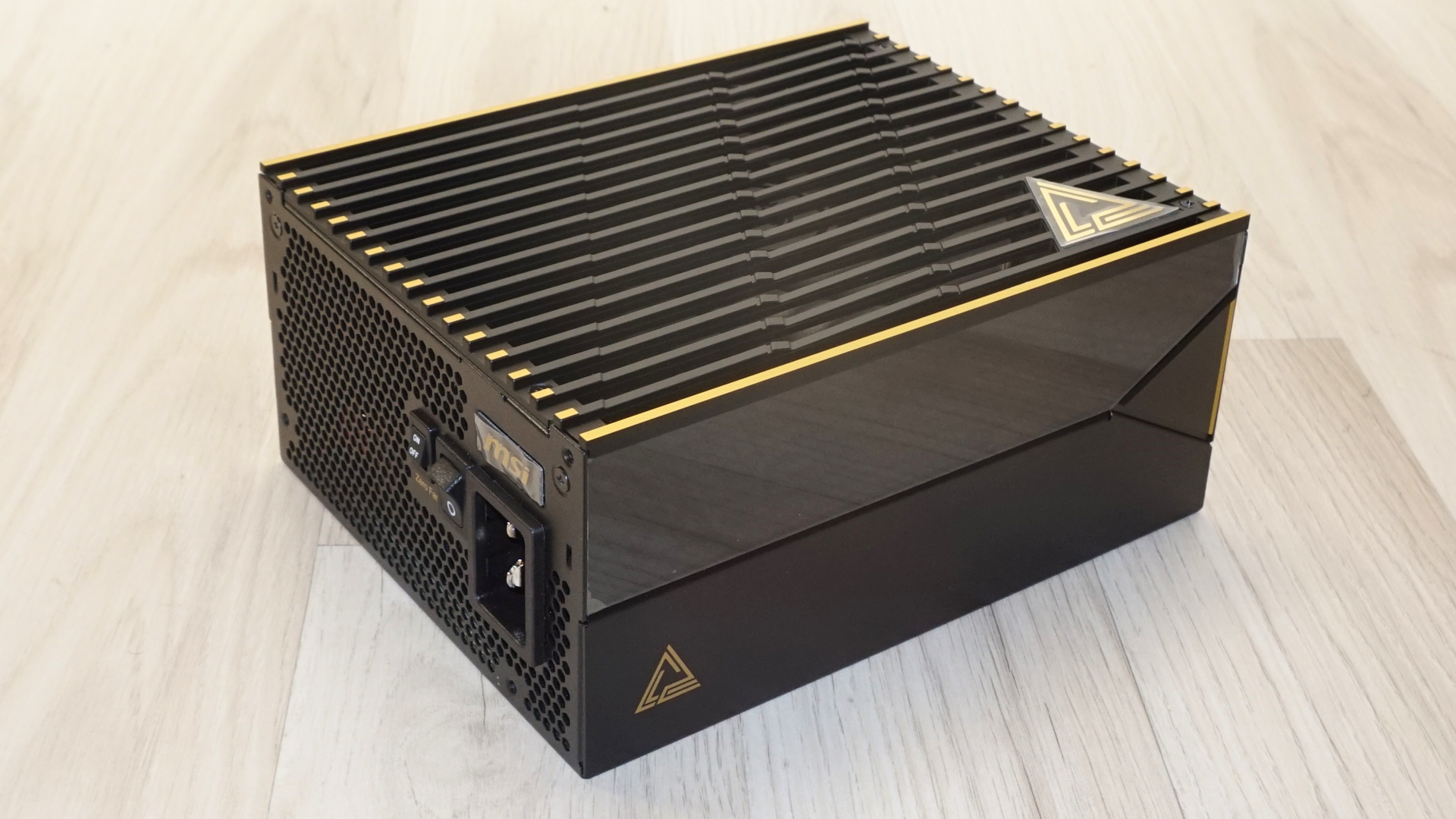
The fan cover utilizes parallel aluminum bars, creating a distinctive vertical wave pattern that adds visual depth to the design. Perhaps most notably, the left side of the unit incorporates a high-resolution RGB panel covering approximately half of its surface area. By default, this displays a golden triangular pattern and the series logo, but users can customize various effects and colors through MSI’s software.
The front panel houses a C20 AC power inlet and on/off switch, complemented by a dedicated button to toggle the hybrid fan mode on or off. The specification sticker is positioned on the top side, while the rear panel contains the modular cable connectors surrounded by a golden legend and the company logo subtly etched in the corner. A USB-C port allows connection to an internal motherboard header for RGB customization and performance monitoring.
Internal Design
The MSI MEG AI1600T employs a Zeta Group (ZIC) ZFB132512H 135mm fan with a dual-ball bearing engine. This fan choice prioritizes reliability and thermal resilience over absolute silence, as dual ball bearing fans are renowned for their durability under high temperatures but tend to produce more noise at higher speeds. However, the fan has a relatively conservative maximum speed of approximately 1800 RPM, and with the unit’s hybrid/zero-RPM capability, it frequently operates in complete silence during typical usage scenarios.
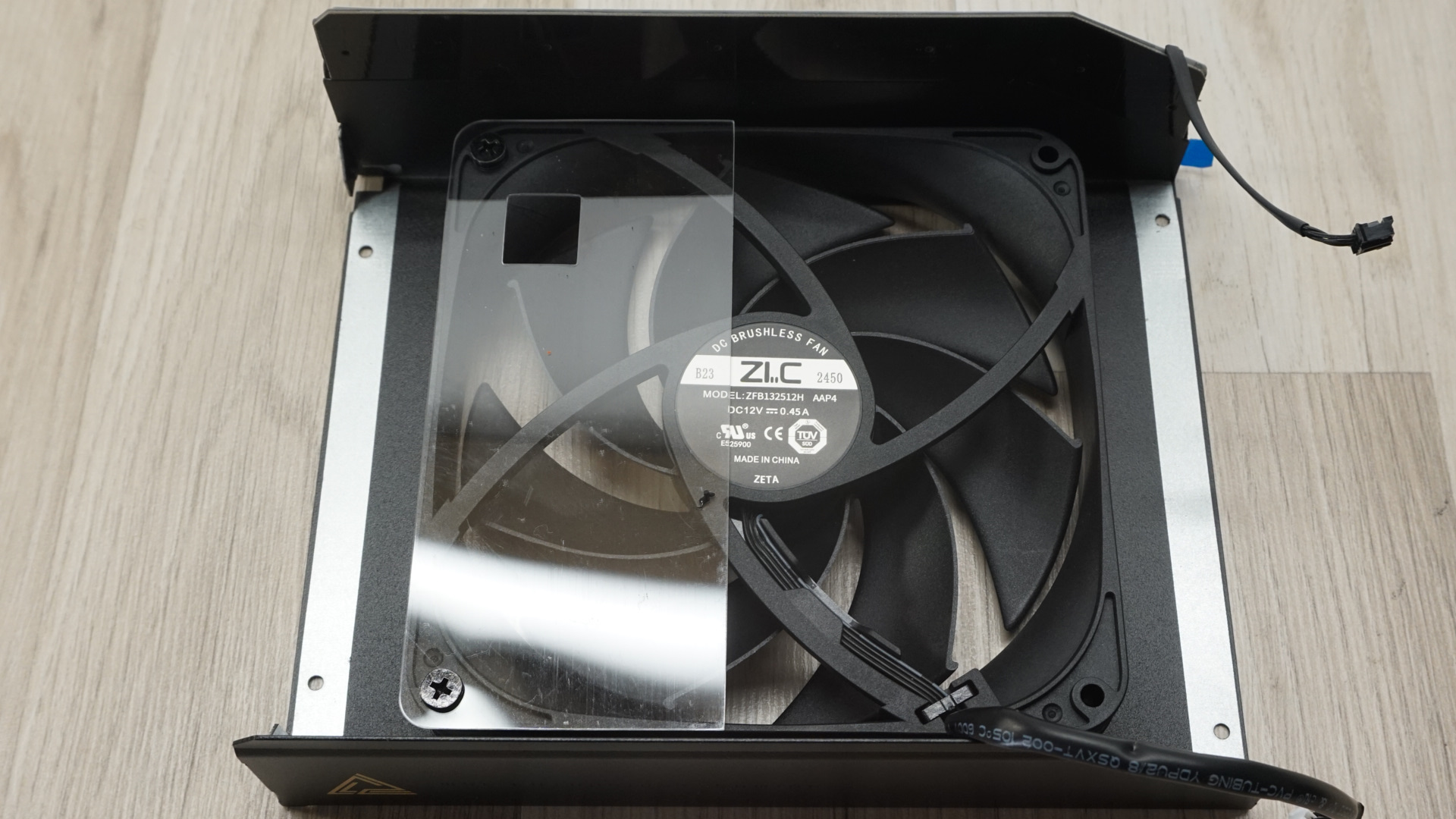
The PSU is manufactured by Channel-Well Technology (CWT), a reputable OEM with extensive experience producing high-end power supplies for numerous brands. CWT has employed a semi-digital platform for this unit, reflecting a design approach increasingly common in premium power supplies.
The input filtering stage is somewhat modest for a unit of this power rating, consisting of four Y capacitors, two X capacitors, and two filtering inductors. The rectification stage employs an interesting hybrid approach, utilizing both a traditional bridge rectifier mounted on a basic metallic heatsink and four digitally controlled MOSFETs on a larger black heatsink.
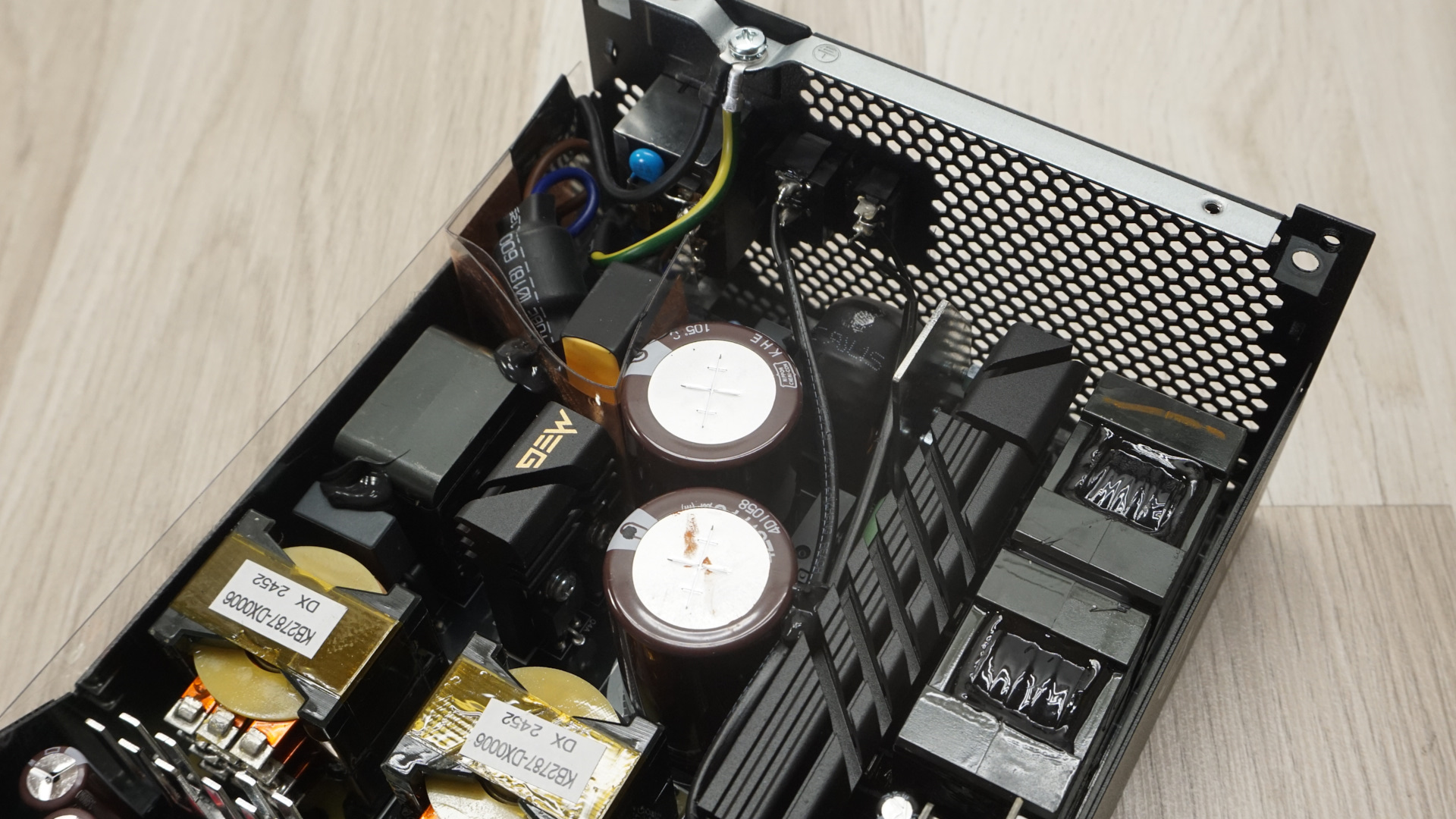
The APFC circuitry incorporates two Infineon 65R050M2H MOSFETs and two diodes, supported by an enhancement mode MOSFET for improved low-load performance. These components occupy their own substantial heatsink that appears initially connected to the rectification MOSFETs heatsink but is actually separate. Two encased inductors and two massive 770μF capacitors from Nippon Chemi-Con complete the APFC stage.
The primary inversion stage employs four Alpha & Omega 29S50 transistors mounted on a sizable black heatsink, implementing a full-bridge LLC topology. These high-efficiency MOSFETs are frequently used in top-tier PSU designs. Twelve MOSFETs generate the primary 12V line on the main PCB’s top surface, immediately following the transformers, with thin silvery heatsinks providing thermal support. The 3.3V and 5V lines are generated by DC-to-DC circuits situated on a large vertical daughterboard.
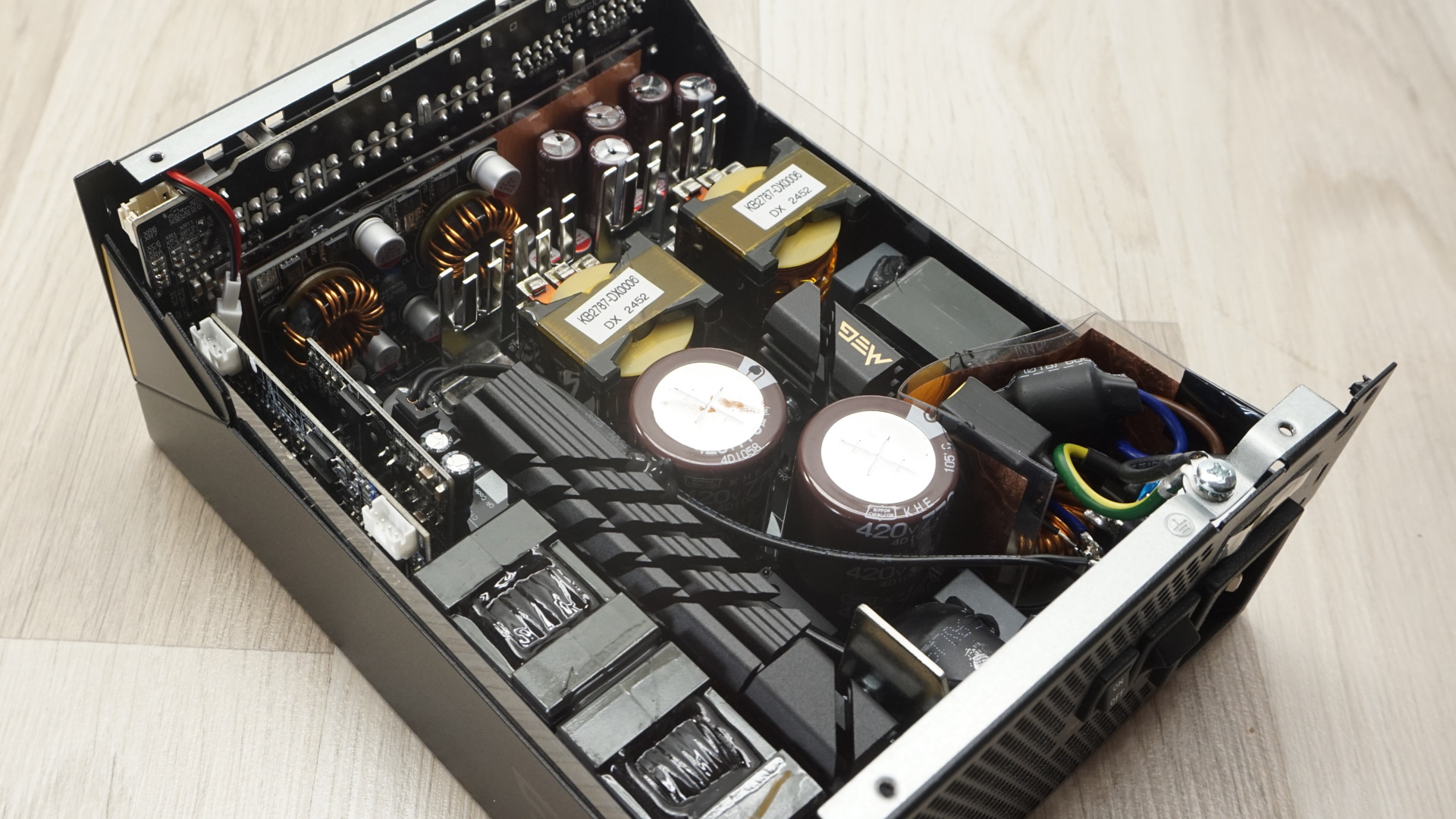
The secondary side capacitors feature a mix of Nippon Chemi-Con and Rubycon products. All capacitors are sourced from highly prestigious Japanese manufacturers – a choice entirely consistent with the product’s flagship status and premium positioning.
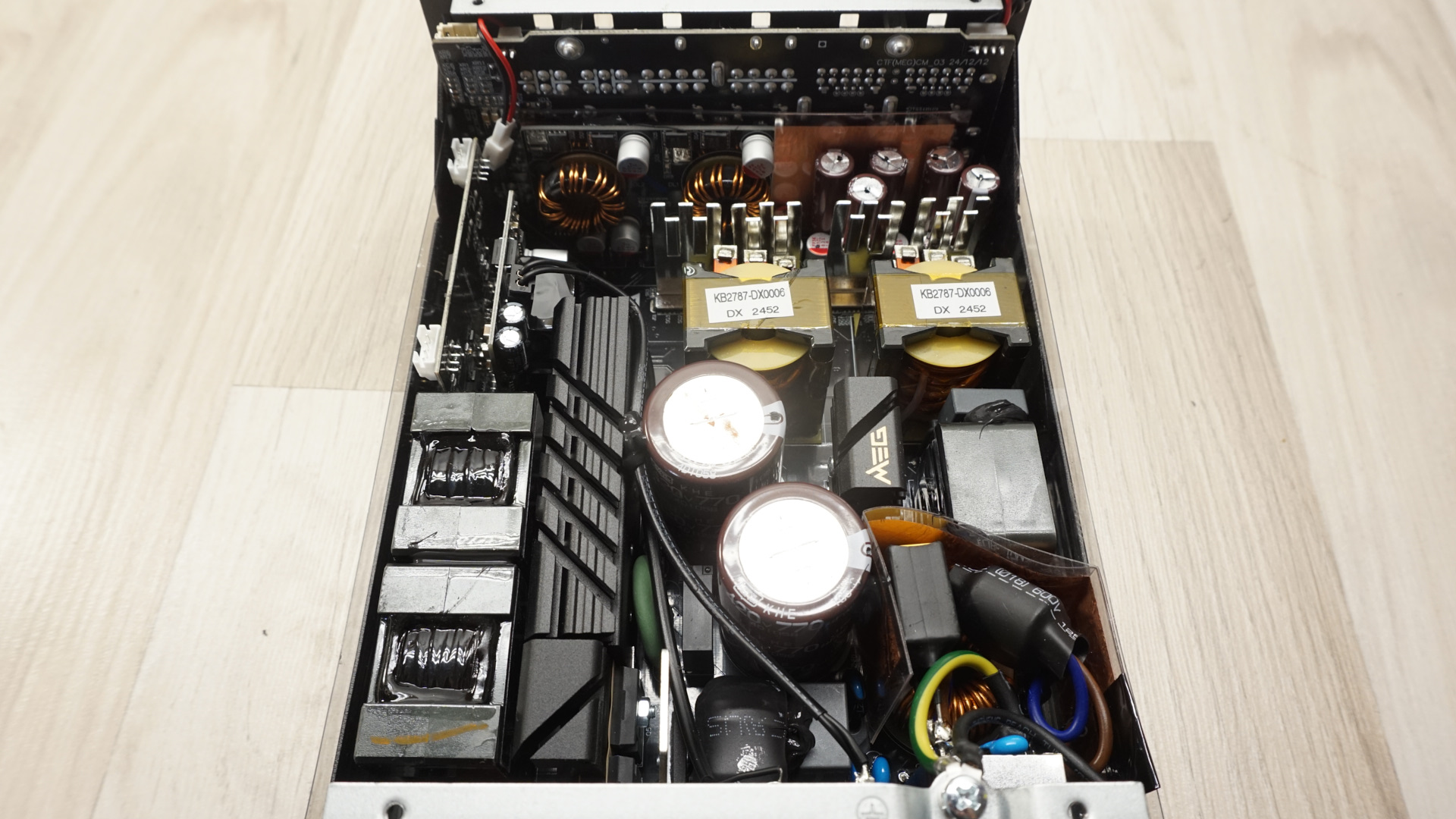
Cold Test Results
Cold Test Results (25°C Ambient)
For testing the power supplies, we use high precision electronic loads with a maximum power draw of 2700 Watts, a Rigol DS5042M 40 MHz oscilloscope, an Extech 380803 power analyzer, two high precision UNI-T UT-325 digital thermometers, an Extech HD600 SPL meter, a self-designed hotbox, and various other bits and parts.
During cold testing, the MSI MEG AI1600T demonstrates outstanding efficiency that meets or exceeds the requirements for 80Plus Titanium certification across global certification bodies including CLEAResult, Cybenetics, and PPLP.INFO. The unit achieves an impressive average nominal load efficiency of 92.7% at 115 VAC and 94.0% at 230 VAC. It is worth noting that CLEAResult’s 80Plus Titanium certification is for 115 VAC input, as the 230 VAC input requires a challenging half-load efficiency of 96%, a benchmark extremely difficult to attain. Efficiency peaks at 50% load but remains remarkably stable across the entire nominal load range (10-100%). Even at very low loads, the unit maintains excellent efficiency levels.
The hybrid cooling system keeps the fan inactive until the load exceeds 900 watts, allowing for completely silent operation under moderate power conditions. When activated, the fan maintains extremely low speeds regardless of load, becoming audible only at maximum capacity. The thermal performance during cold testing is impressive, with internal temperatures remaining well-controlled despite the unit’s substantial power output.
Hot Test Results
Hot Test Results (~45°C Ambient)
When tested with elevated ambient temperatures, the MSI MEG AI1600T demonstrates good resilience but the efficiency decrease compared to cold conditions is easily measurable. The unit achieves an average nominal load efficiency of 91.6% at 115 VAC and 92.9% at 230 VAC, reflecting a reduction from cold testing results greater than 1%. Slightly greater efficiency degradation occurs at heavy loads, which could indicate mild thermal stress.
Under high ambient temperatures, the fan activates at a significantly lower threshold of approximately 600 watts, accelerating more rapidly than in cold testing conditions. However, it still never reaches maximum speed, even at 100% load. Despite the increased cooling demands, internal temperatures remain relatively low for a unit of this power class, signifying a thermal design that prioritizes quiet operation over absolute thermal performance.
PSU Quality and Bottom Line
Power Supply Quality
The MSI MEG AI1600T offers solid electrical performance. The 12V rail regulation at 0.6% is reasonably tight given the unit’s massive power output, but the 5V and 3.3V rails show more variance at 1.4% and 1.2% respectively. These secondary rail numbers, while acceptable, fall short of what we would expect in this ultra-premium price bracket, where competitors casually deliver sub-1% regulation across all rails. Ripple suppression is good but unexceptional for a flagship product, with maximum levels reaching 44 mV on the 12V rail, 22 mV on the 5V rail, and 28 mV on the 3.3V rail. While these values comfortably meet ATX specifications, they do not particularly stand out in the high-end segment where we have seen competing units maintain ripple below 30 mV on the primary 12V rail even at full load. For a power supply commanding such a premium price, the electrical performance is satisfactory rather than extraordinary.
During our thorough assessment, we evaluate the essential protection features of every power supply unit we review, including Over Current Protection (OCP), Over Voltage Protection (OVP), Over Power Protection (OPP), and Short Circuit Protection (SCP). Protection features function effectively, with Over Current Protection (OCP) thresholds set at 120% for the 12V rail and significantly higher at 140% and 135% for the 3.3V and 5V rails respectively. The Over Power Protection (OPP) engages at 125% during hot testing, providing an appropriate safety margin while allowing for reasonable power headroom.
Load (Watts) | 322.69W | Row 0 – Cell 2 | 805.98W | Row 0 – Cell 4 | 1204.58W | Row 0 – Cell 6 | 1604.7W | Row 0 – Cell 8 |
Load (Percent) | 20.12% | Row 1 – Cell 2 | 50.37% | Row 1 – Cell 4 | 75.29% | Row 1 – Cell 6 | 100.29% | Row 1 – Cell 8 |
Amperes | Volts | Amperes | Volts | Amperes | Volts | Amperes | Volts | |
3.3 V | 2.08 | 3.37 | 5.2 | 3.36 | 7.8 | 3.35 | 10.41 | 3.33 |
5 V | 2.08 | 5.12 | 5.2 | 5.12 | 7.8 | 5.06 | 10.41 | 5.05 |
12 V | 25.23 | 12.09 | 63.07 | 12.08 | 94.6 | 12.04 | 126.14 | 12.03 |
| Row 6 – Cell 0 | Row 6 – Cell 1 | Row 6 – Cell 2 | Row 6 – Cell 3 | Row 6 – Cell 4 | Row 6 – Cell 5 | Row 6 – Cell 6 | Row 6 – Cell 7 | Row 6 – Cell 8 |
Line | Regulation (20% to 100% load) | Voltage Ripple (mV) | Row 0 – Cell 3 | Row 0 – Cell 4 | Row 0 – Cell 5 | Row 0 – Cell 6 | Row 0 – Cell 7 |
| Row 1 – Cell 0 | Row 1 – Cell 1 | 20% Load | 50% Load | 75% Load | 100% Load | CL1 12V | CL2 3.3V + 5V |
3.3V | 1.2% | 12 | 14 | 18 | 28 | 16 | 26 |
5V | 1.4% | 10 | 16 | 20 | 22 | 12 | 22 |
12V | 0.55% | 14 | 20 | 32 | 44 | 42 | 18 |
Bottom Line
The MSI MEG AI1600T PCIE5 stands as MSI’s flagship power supply offering, targeting the rarefied market of users with extreme power requirements who prioritize performance, efficiency, and distinctive aesthetics – perhaps at any cost. While this “halo product” certainly showcases MSI’s engineering ambitions, the stratospheric price point raises legitimate questions about value even within the premium segment.
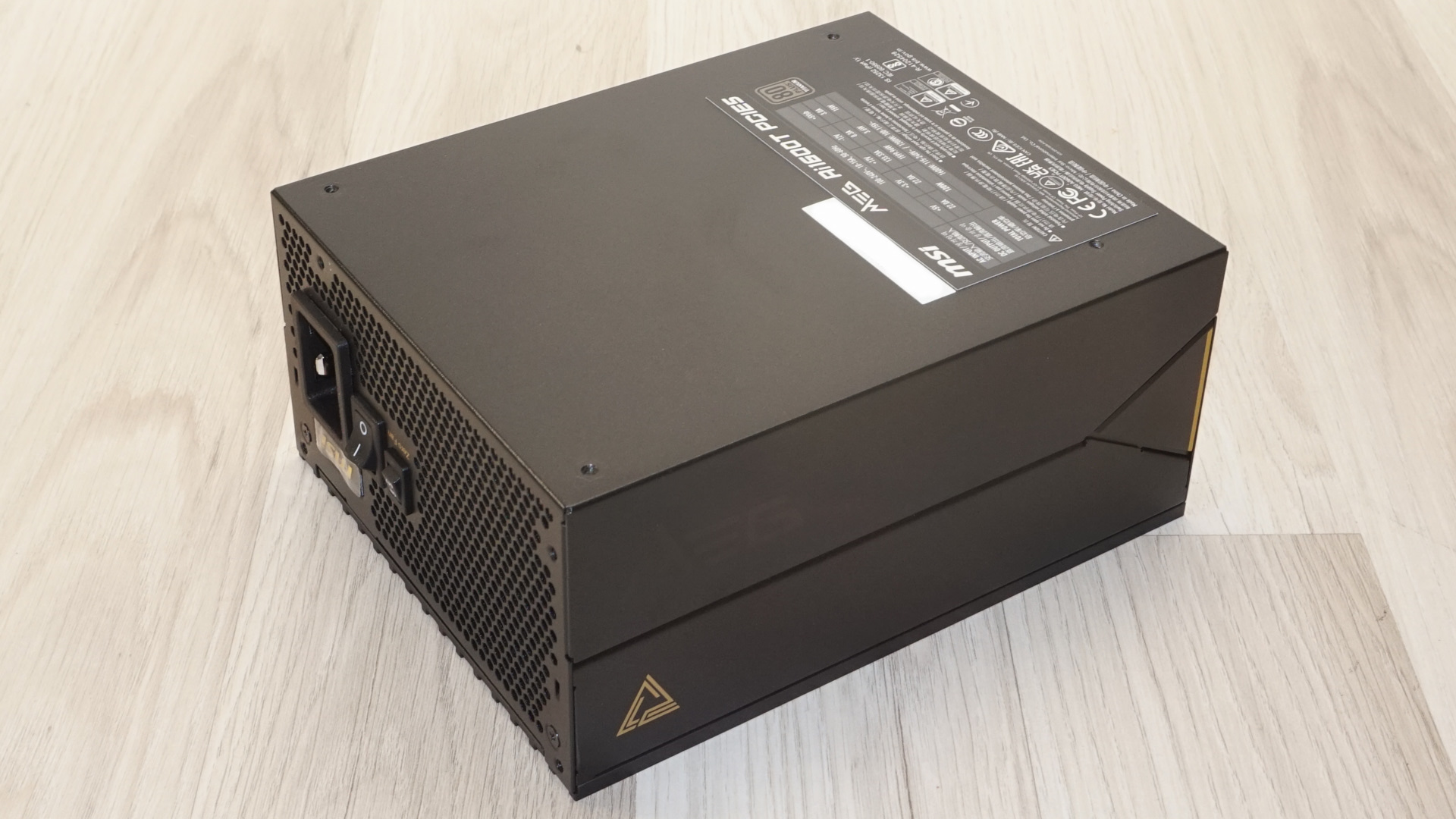
The external design undeniably impresses, combining premium materials with distinctive visual elements that set it apart from typical power supplies. The high-resolution RGB display panel covering half of one side is certainly unique in the PSU space, offering customization options through MSI’s software ecosystem. The individually sleeved cables with pre-installed combs reflect attention to detail, offering both functional benefits for cable management and aesthetic appeal. MSI’s thoughtful safety features, like the half-yellow PCIe connectors that visually confirm proper connection, demonstrate practical innovation alongside the digital interface that enables monitoring and fan control customization. Finally, the digital interface with the motherboard that allows for monitoring and some basic control is unique to top-tier PSU products.

In efficiency metrics, the MEG AI1600T delivers as promised, achieving Titanium certification across multiple global standards including CLEAResult, Cybenetics, and PPLP.INFO. Load efficiency remains admirably stable throughout its operating range and degrades only minimally under high-temperature conditions, speaking to the fundamental engineering competence of the design. However, when examining electrical performance, the picture becomes more nuanced. While voltage regulation on the crucial 12V rail is commendable at 0.6%, the secondary rails show less impressive figures at 1.4% and 1.2% for 5V and 3.3V respectively. Similarly, ripple suppression, while meeting specifications with headroom to spare, does not break new ground for a unit positioned at the absolute premium tier of the market.
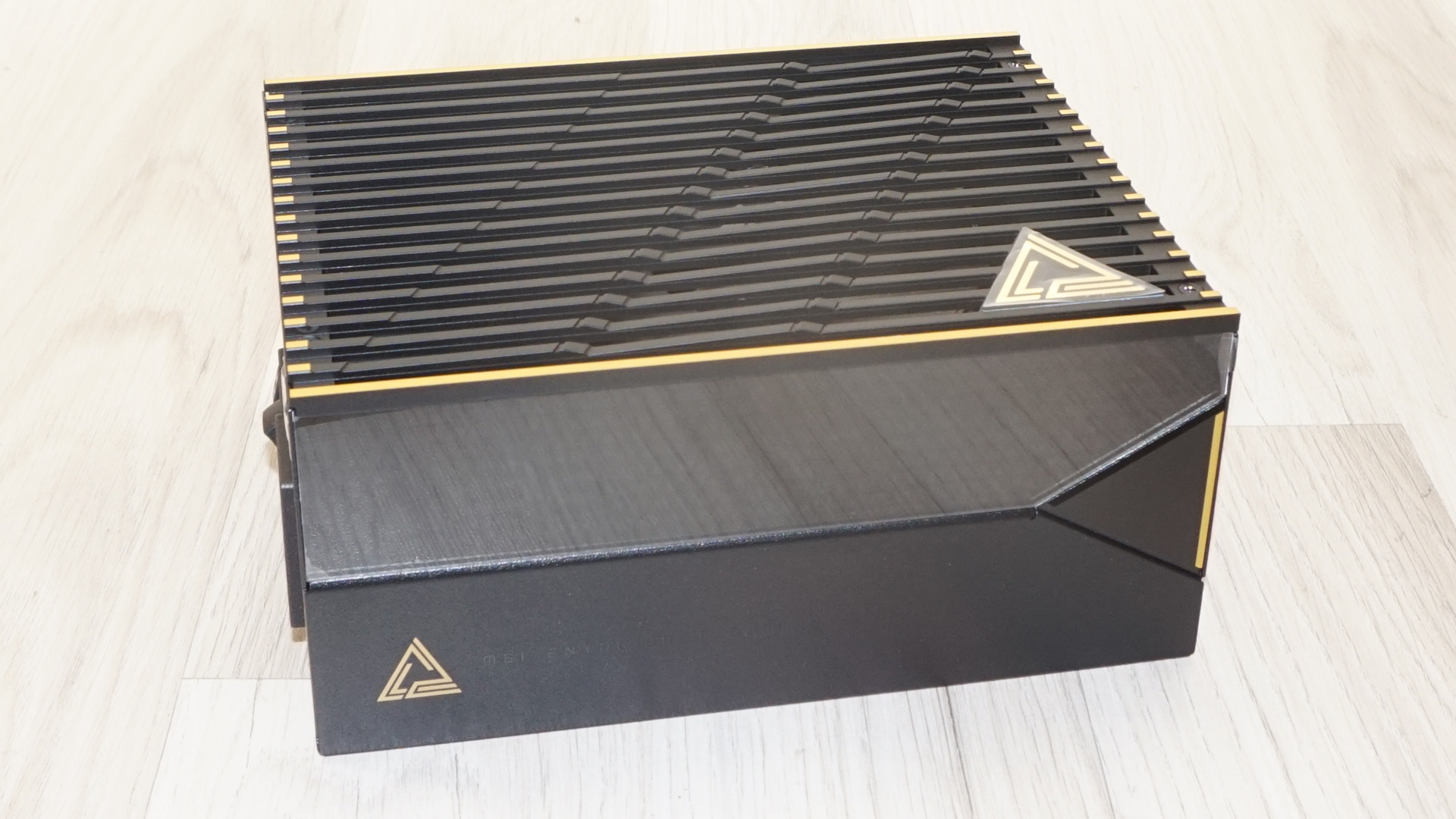
Thermally, the unit performs well but not exceptionally, maintaining reasonable internal temperatures even at high outputs. The cooling system is clearly tilted towards low noise operation, with the fan remaining inactive until loads exceed 900W under normal conditions (though this threshold drops significantly to around 600W in elevated ambient temperatures). This approach prioritizes silence during typical usage scenarios while ensuring adequate cooling when the unit is pushed harder, but temperatures can get high. The default cooling profile can be adjusted by users via the unit’s digital interface.
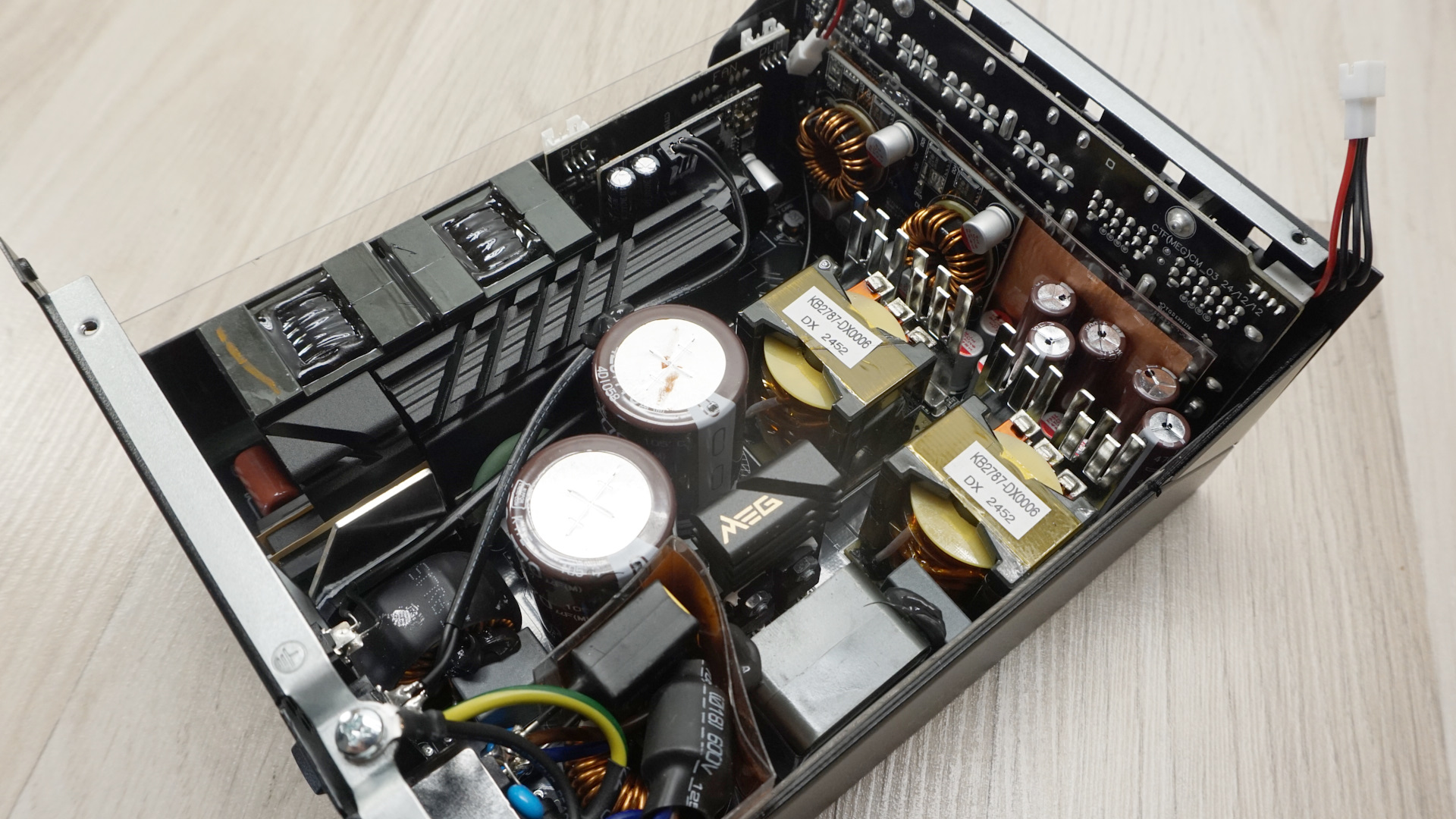
The real elephant in the room is the MEG AI1600T’s eye-watering $690 retail price, a figure that is difficult to justify, no matter how good the performance is. This represents a substantial premium even compared to other Titanium-rated 1600W units from respected manufacturers, many of which offer comparable or superior electrical characteristics at significantly lower price points. What MSI provides for this premium seems to primarily be aesthetic distinction and integration with their software ecosystem, which may appeal to builders committed to MSI-centric systems but offers questionable value for most others.
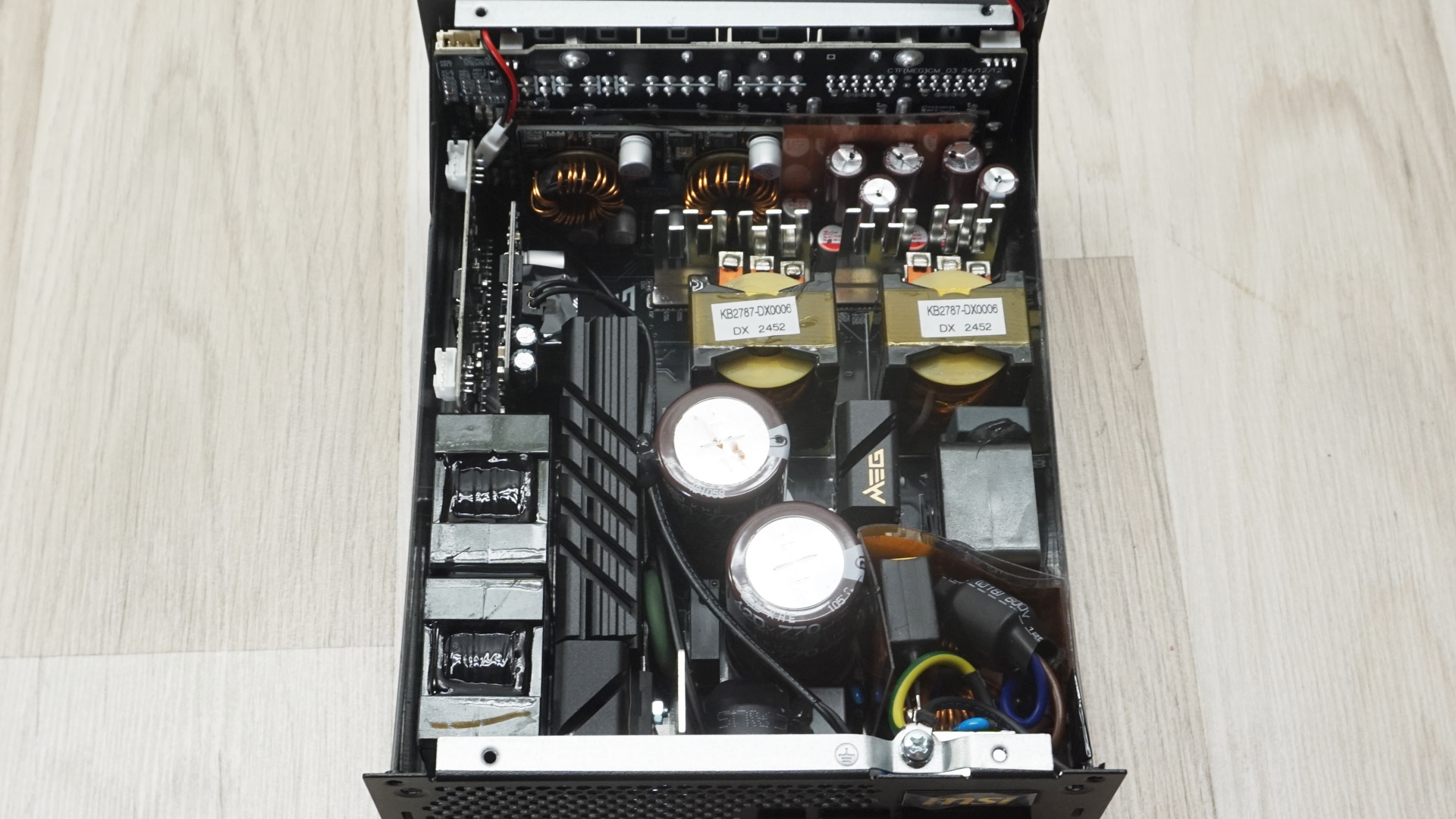
In conclusion, the MSI MEG AI1600T PCIE5 is a technically competent power supply with distinctive aesthetics and integration features, wrapped in a package that commands an extraordinary price premium. For the vanishingly small segment of users who simultaneously require 1600W of power, are invested in the MSI ecosystem, and prioritize the unit’s unique visual elements, it represents a functional – if financially extravagant – choice.
MORE: Best Power Supplies
MORE: How We Test Power Supplies
MORE: All Power Supply Content


